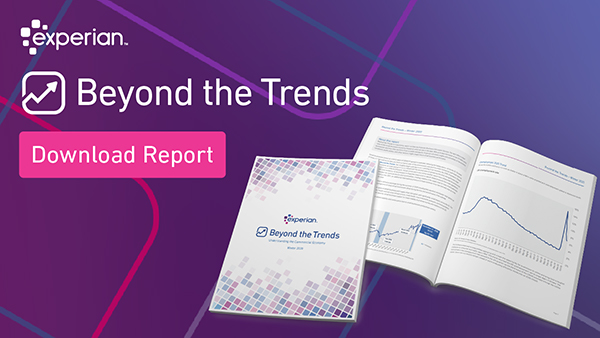Tag: beyond the trends

We've all been experiencing higher prices for food, housing, and certainly at the gasoline pump. If these economic headwinds have raised concerns about how small businesses are being impacted, we have some fresh perspectives in the Spring 2022 Beyond the Trends report. Beyond The Trends offers a unique view of the small business economy based on what we see in the data. With up to date information on over 25 million active businesses and how they perform from a credit standpoint. Here’s my quick take on what’s in our latest Beyond The Trends Report The next 12 months will be filled with headwinds and mines for small businesses. These entities have been shoring up resources, operations, building in cost increases, and creating backup supplier networks as supply chain disruption and inflation will batter the ship through 2023. Highlights: Consumers seek higher paying jobs, creating labor shortages in blue collar industries, as wage gains are being eaten away by increasing U.S. inflation. Transportation and the utility industries have seen a 69% increase in delinquent balances tied closely to the increase in U.S. inflation. A 4X increase in delinquent balances associated with mining as the US took steps to move away from fossil fuel. Commercial card lending grew 9.9% in the 4th quarter, even as delinquency rates began their upward climb. Energy Takes Center Stage Energy costs are hitting margins and impacting delivery of goods and services. US energy costs were up 27% in January according to the Bureau of Labor and Statistics. These costs have been rising sharply since March 2021 and will be exacerbated in the 1st quarter 2022 by global reaction to the Russian incursion in Ukraine. Energy supply chains will be disrupted by sanctions and higher transport costs. !function(e,i,n,s){var t="InfogramEmbeds",d=e.getElementsByTagName("script")[0];if(window[t]&&window[t].initialized)window[t].process&&window[t].process();else if(!e.getElementById(n)){var o=e.createElement("script");o.async=1,o.id=n,o.src="https://e.infogram.com/js/dist/embed-loader-min.js",d.parentNode.insertBefore(o,d)}}(document,0,"infogram-async"); Inflation Looms Consumers and small businesses will feel the pinch of lower supply and higher costs. Inflation, outside this event and on the rise, will remain above the Federal Reserve target of 2% through the end of 2022, even as the Fed raises rates and begins to reduce their balance sheet. The US supply chain will be in a slow recovery mode as infrastructure stimulus and global markets return to capacity. Small businesses are adjusting to a high demand low supply market through 2023. !function(e,i,n,s){var t="InfogramEmbeds",d=e.getElementsByTagName("script")[0];if(window[t]&&window[t].initialized)window[t].process&&window[t].process();else if(!e.getElementById(n)){var o=e.createElement("script");o.async=1,o.id=n,o.src="https://e.infogram.com/js/dist/embed-loader-min.js",d.parentNode.insertBefore(o,d)}}(document,0,"infogram-async"); Download Spring Beyond The Trends Report

This perception of the marketplace has been a concern of consumers and small business owners, in the US, as they manage through the pandemic hampered marketplace. Small businesses are adjusting to a high demand/ low supply market that is expected to continue through 2022. The ability to move raw materials to manufacturers, products across borders, find space in warehouses, and put products on the shelf has become challenging as pandemic variants add pressure to a slowly recovering supply infrastructure. Large market participants will find disproportionate advantage, over small business competitors, widens as distributors focus on their largest clients and small clients feel cost and availability squeeze. Consumers store front engagement will increase, with a tangible delivery advantage, as distrust grows in a digital only storefronts ability to deliver on time. Here's my quick take on what's in our latest Beyond The Trends Report The Experian Winter 2021 Beyond the Trend report looks at consumer willingness and ability to spend behavior tied to the bets commercial supply chain industry participants are making, to ensure demand is met, emerging from the heart of the pandemic: Originations for new businesses, with less than a year in business and already participating in the commercial credit market, are up 157% from pre-pandemic levels. 36% of active U.S. businesses have been operating less than 1 year, as the spike in new business applications continue to be elevated. Commercial lending up 95% from same time last year to supply chain participants (Manufacturing, wholesale, retail, transportation, and warehouse) Although delinquency rates are historically low rates for wholesalers (Up 600%) and retailers (Up 101%) have been on the rise a components and inventories are slow to arrive. To operate at full capacity, small businesses will need consumers willing to spend. The fed will begin to taper and raise rates much earlier than expected, March 2022, to add downward pressure to inflation. Small businesses are betting on growth as investors view variants as a bump in the road vs a blocker. New business applications continued to roll at ~400k a month in 2021. This untapped market expansion will drive traditional lenders to reassess the risk of engaging emerging businesses in their first year of operation with limited historical commercial performance. !function(e,i,n,s){var t="InfogramEmbeds",d=e.getElementsByTagName("script")[0];if(window[t]&&window[t].initialized)window[t].process&&window[t].process();else if(!e.getElementById(n)){var o=e.createElement("script");o.async=1,o.id=n,o.src="https://e.infogram.com/js/dist/embed-loader-min.js",d.parentNode.insertBefore(o,d)}}(document,0,"infogram-async"); Supply chain bottlenecks will slowly dissipate. We expect to see variability in product availability as goods are delivered which will create scenarios of over-supply of some products while others remain tied up in transit. Lenders and creditors should monitor commercial health of businesses they interact with directly and indirectly to ensure portfolio stability and accurate risk based pricing. 2022 will be a recovery year for the US market. Consumers keep shopping! Small businesses keep fighting! The shelves will be full soon. Download Winter 21/22 Report

Beyond the Trends Spring 2021 - now available We're excited to announce the release of our second Beyond the Trends report. This report's going to deep dive into the economic trends that we're seeing in the market now. We look at some commercial and consumer credit trends that will impact recovery. And we'll deep dive into some of the industries that are most impacted. One of the things we talk about in this edition is economic growth. As excitement builds within the markets and reopening continues across different regions, we see an expectation for 7% GDP growth in the U.S. We're seeing a 27% increase in business starts year-over-year, and businesses reopened. We have new businesses emerging as well. In this report, we'll look at ways that lenders, as well as businesses, will be seen in credit markets and how growth can occur. Finally, with new stimulus in the market, consumers are ready to spend. Small businesses will look for opportunities to move from security mode and safety mode, business preservation into a transformational growth mode. Stay informed by downloading your copy of the Beyond the Trends report. Download the latest report

New Experian Report: Beyond the Trends Experian Business Information Services is excited to present our new quarterly report "Beyond the Trends." In this report, we'll be evaluating challenges to particular industries. We'll be looking at account management, pre-treatment, and treatment strategies for small businesses coming out of COVID. The Winter edition has just been released, download your copy below. . Download Report
